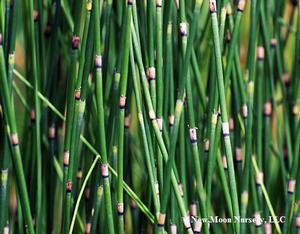New Moon Nurseries
Equisetum hyemale
scouring rush, rough horsetail
Native to North America
FIRST IMPRESSIONS: Equisetum hyemale is a vigorous evergreen perennial with a striking vertical habit. Plants produce multiple bamboo-like dark green stems arranged in dense clumps. This handsome rush-like plant adapts to a wide variety of growing conditions but is found most often in sunny or partly shaded wetlands or water gardens.
HABITAT & HARDINESS: Equisetum hyemale ranges through Eurasia, most Canadian provinces, Alaska, Greenland and the contiguous United States.
This species occurs in wet open woods, riparian zones of streams and rivers, shores of lakes and ponds, alluvial flats, springs, seeps, prairie swales, marshes, swamps, ditches, pastures and gravelly railroad right-of-ways. Equisetum hyemale is found more often in disturbed sites than in high quality natural areas.
Hardy from USDA Zones 4-9.
PLANT DESCRIPTION: Equisetum hyemale is a vigorous perennial with aggressive burrowing rhizomes.
Dense clumps of rigid upright stems arise from the rhizomes. The attractive stems are cylindrical, hollow and less than ½” across.
Each stem has vertical ridges and is jointed or segmented. The nodes contain rings of tiny scale-like leaves and dark gray sheaths with black bands.
Occasionally fertile stems develop 1-2” yellowish or reddish spore bearing cones. The cones wither by late summer after the spores have been released.
This species is 2-4’ tall and 1-6’ wide. Plants form large dense colonies from their robust rhizomes.
CULTURAL & MAINTENANCE NEEDS: Equisetum hyemale thrives in sunny or shady sites with moist to wet soil.
Plants adapt to sandy, gravelly, clay or saturated mucky soils and sites with shallow standing water or fluctuating water levels. This species tolerates drought and acid or alkaline soil.
In gardens, this aggressive plant should be confined with deep soil barriers or in pots without drainage holes. Rhizomes are extremely vigorous and have the ability to deeply penetrate the soil and grow under sidewalks or retaining walls.
This species is pest resistant and unpalatable to deer and other herbivores.
LANDSCAPE USES: Equisetum hyemale is a pleasing Accent plant that is useful for Containers, Rain Gardens and Water Gardens. Plants provide Erosion Control and Winter Interest and are appropriate for Deer Resistant Plantings and Stormwater Management Projects.
Plants should be sited with care, however, due to their penchant to escape and colonize unauthorized areas.
COMPANION & UNDERSTUDY PLANTS: In natural areas, Equisetum hyemale often occurs in monotypic stands. If confined in garden situations, it mingles nicely with Asclepias incarnata, Lobelia cardinalis, Iris versicolor, Iris virginica and wetland sedges like Carex comosa.
Juncus effusus has similar size, texture and cultural needs and can be substituted in a pinch.
TRIVIA: Equisetum hyemale is a “living fossil” with relatives that thrived during the Devonian period about 350 million years ago.
In certain types of light, the hollow stems appear to glow from within.
Historically due to a high silica content, the stems have been used to scour or polish wood and metal.
Also known as horsetail, marestail, horse pipes, jointed monkey grass, or snake grass.
This species is described as a “rush”, but is more closely related to spore bearing ferns. When spores land in a moist spot, they can grow into a small multi-cellular moss-like plants. These garmetophytes produce eggs and sperm that join to form the next sporophyte generation.
Equisetum hyemale provides cover and nesting sites for wildlife.
Height:
2-4 ftSpread:
1-6 ftSpacing:
2-8 ftUSDA Hardiness Zone:
4-9Bloom Color:
GreenEquisetum hyemale Characteristics
Attracts Wildlife
- Songbirds
- Pollinators
Attributes
- Rock Garden
- Coastal
- Naturalizing
- Clay Soil
- Interesting Foliage
- Bog
- Evergreen
- East-Coast Native
- Dried Flower
- Container
- Rain Garden
Exposure
- Full Sun to Partial Shade
Deer Resistant
- Deer Resistant
Flowering Months
- August
- July
Foliage Color
- Green
Growth Rate
- Fast
Season of Interest (Foliage)
- Fall
- Summer
- Spring
- Winter
Soil Moisture Preference
- Moist
- Wet to Moist
- Wet
- Moist to Wet
Interesting Notes:
Equisetum hyemale is a “living fossil” with relatives that thrived during the Devonian period about 350 million years ago.
In certain types of light, the hollow stems appear to glow from within.
